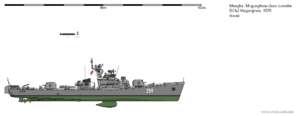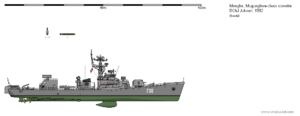Mugunghwa-class corvette
 DChJ Mugunghwa as commissioned.
| |
| Class overview | |
|---|---|
| Name: | Mugunghwa class |
| Builders: |
|
| Operators: | Menghe |
| Preceded by: | Banjihwa-class corvette |
| Succeeded by: | |
| Built: | 1971-1984 |
| In service: | 1975-2010 |
| Completed: | 32 |
| Lost: | 1 |
| Retired: | 31 |
| General characteristics | |
| Type: | Anti-submarine corvette |
| Displacement: | 1,260 tonnes full load |
| Length: |
|
| Beam: | 9.6 m |
| Draft: | 3.0 m (to keel) |
| Propulsion: |
|
| Speed: | 32 knots |
| Range: | 2,200 nautical miles (4,000 km) at 12 knots |
| Endurance: | 15 days |
| Complement: |
|
| Sensors and processing systems: |
|
| Electronic warfare & decoys: | Bizan-4B ESM radar system |
| Armament: |
|
The Mugunghwa-class corvettes were a group of 32 warships built in the Democratic People's Republic of Menghe during the 1970s and 1980s as a follow-on to the Banjihwa-class corvettes. Compared with their predecessors, they had moderately improved range and endurance, an enclosed bridge for better visibility, longer-ranged torpedoes, and a dipping sonar. While relatively inexpensive to build and operate, they suffered, like their predecessors, from inadequate anti-air and anti-surface armament.
Development
The Mugunghwa-class corvettes were developed during the late 1960s as an evolutionary replacement for the Banjihwa-class corvettes, themselves license-built versions of the Letnian Petya-class frigate. Their design borrowed heavily from that of the Banjihwa class: the propulsion system was entirely identical, and the sonar was the same type. The hull design was also borrowed from the Banjihwa class, though it was not simply a stretched or plugged Banjihwa hull, as foreign analysts first believed: in fact, the hull was slightly widened and deepened, and followed a different profile forward of the "A" position 76mm turret. This larger hull allowed somewhat more comfortable living conditions and increased storage space, which together increased the ships' at-sea endurance.
Characteristics (as built)
Despite their different hull form, the Mugunghwa-class corvettes were similar in their internal layout to their predecessors. The powerplant was copied from the Letnian type, with two M-2B 15,000 hp gas turbines for sprint operations and one diesel engine for cruising. Each engine was hooked up to a single propeller shaft; on gas turbine power, the diesel engine's centerline shaft would trail in the water with the propellers feathered, and vice versa while cruising. The powerplant was relatively noisy in both modes, interfering in passive sonar detection and making it easy for submarines to avoid the ship.
The main anti-submarine armament of the Mugunghwa-class corvettes was a quintuple torpedo tube launcher mounted aft of the funnel. This was capable of launching wire-guided homing torpedoes. Forward of the bridge, the ships also carried two RBU-6000 depth charge rocket launchers, which could reload automatically from a magazine below decks. On the quarterdeck, the ships could mount depth charge racks over the ends of their mine rails, an anachronistic feature even for the 1970s. Anti-submarine sensors consisted of a hull-mounted MG-312 "Titan" sonar and a dipping sonar on the quarterdeck; the latter could only be deployed while stationary.
Self-defense armament consisted of two AK-726 twin 76mm turrets and one manually-aimed surface-to-air missile launcher. On early-production hulls this carried two YDG-31 missile tubes and four reloads; it was later modified to carry YDG-34 missile tubes. Both are heat-seeking man-portable air-defense systems, and do not rely on radar for guidance. Eight to twelve reloads are carried in a box aft of the funnel.
Refits and modifications

Juksun, the 26th ship in the class, was completed in December 1981 as a trials ship for the YDG-36 anti-ship missile. In place of her aft turret, she carried an eight-box traversing launcher and missile magazine, as well as a guidance radar. The dipping sonar, main sonar, and 533mm torpedo tubes were retained, and following trials Juksun has been seen on regular patrols, suggesting that the ship was still a fully operational ASW patrol ship despite her unusual modified layout.
Yusu, the 4th ship in the class, was modified in 1991 to carry a towed array sonar of unknown origin, likely either domestic or copied from a foreign source. This required the deletion of the aft turret. The sonar handling equipment was left mostly exposed, suggesting that Yusu was testing a sonar system for a future corvette class rather than a prospective Mugunghwa upgrade.
The actual Mugunghwa upgrade first appeared in 1996, and used a variable-depth sonar of Menghean design. Unlike the old dipping sonar, this could be deployed while moving, and it was reportedly more sensitive in the active and passive modes. The sonar, sonar handling equipment, and sonar control room were placed in a large deckhouse aft, which covered the entire quarterdeck but did not require the removal of the aft turret. The air and surface search radar was also replaced with a newer type, and the torpedo tubes and combat control system were modified to support the HŎ-2 Poksŏl. Only eight ships were rebuilt in this way; ships from DChS-621 Jangsu onward were directly retired when reaching the date for their mid-life refits.
In 2002, Juksun was seen with a Subisu CIWS mount in place of the YDG-36 launcher. This may have been meant to test the ability of the Subisu to fit in the missile magazine of the YDG-36 system, or to test the Subisu's suitability for small combatants. The Subisu system was functional in this configuration, and was even tested against target drones, but the ship apparently suffered from serious weight distribution issues. She did not embark on any patrols in this configuration, and she was decommissioned in 2005.
Operational service
The Mugunghwa-class corvettes were originally intended as green-water combatants, able to patrol areas within 500 kilometers of Menghe's coast. For this role, they had moderate autonomy given their size, and no onboard helicopter facilities, as they would rely on shore-based patrol aircraft. They did, however, carry variable-depth dipping sonar to detect targets below the thermocline.
Due to their small displacement and low freeboard, they proved to be poor seaboats on the open ocean, especially in stormy weather. One ship in the class, Rŭngsohwa, capsized in a typhoon in 1996, killing all on board. After this incident, Mugunghwa-class ships were mostly relegated to coastal patrol duties, and plans to decommission them were accelerated.
Ships in the class
| Hull no. | Name | Builder | Launched | Commissioned | Fate |
|---|---|---|---|---|---|
| DChS-612 | Mugunghwa | Kimhae | 1973-08-24 | 1975-03-07 | Refitted 1995-1996; decommissioned 2008; sold for scrap |
| DChS-613 | Chijahwa | Kimhae | 1974-05-31 | 1975-09-18 | Refitted 1997-1998; decommissioned 2009; sold for scrap |
| DChS-614 | Chaegryŏk | Gyŏngsan | 1974-09-29 | 1976-05-11 | Refitted 1995-1996; decommissioned 2009; sold for scrap |
| DChS-615 | Yusu | Kimhae | 1974-09-10 | 1975-12-27 | Refitted 1991 as sonar trials ship; decommissioned 2005; sold for scrap |
| DChS-616 | Pianhwa | Gyŏngsan | 1975-03-26 | 1976-11-18 | Refitted 1997-1998; decommissioned 2009; sold for scrap |
| DChS-617 | Sangsu | Gyŏngsan | 1974-12-21 | 1976-05-18 | Refitted 1997-1998; decommissioned 2009; sold for scrap |
| DChS-618 | Baegryangsu | Kimhae | 1975-07-20 | 1976-12-15 | Refitted 1998-1999; decommissioned 2009; sold for scrap |
| DChS-619 | Chajŏncho | Kimhae | 1975-12-04 | 1977-08-16 | Refitted 1997-1998; decommissioned 2010; sold for scrap |
| DChS-620 | Jangsu | Gyŏngsan | 1975-11-18 | 1977-03-20 | Refitted 1998-1999; decommissioned 2010; sold for scrap |
| DChS-621 | Buyonghwa | Gyŏngsan | 1975-11-26 | 1977-01-21 | Decommissioned 1997-01-31; sold for scrap |
| DChS-622 | Gwisu | Gyŏngsan | 1976-03-20 | 1977-11-06 | Decommissioned 1997-01-31; sold for scrap |
| DChS-623 | Aenghwacho | Kimhae | 1976-06-17 | 1978-03-14 | Decommissioned 1997-01-31; sold for scrap |
| DChS-624 | Rapalhwa | Kimhae | 1977-01-15 | 1978-09-19 | Decommissioned 1997-01-31; sold for scrap |
| DChS-625 | Ogranhwa | Gyŏngsan | 1976-11-09 | 1978-03-24 | Decommissioned 1998-05-15; sold for scrap |
| DChS-626 | Hwangdu | Gyŏngsan | 1976-11-23 | 1978-08-29 | Decommissioned 1998-05-15; sold for scrap |
| DChS-627 | Baeksu | Gyŏngsan | 1977-02-19 | 1978-10-31 | Decommissioned 1998-05-15; sold for scrap |
| DChS-628 | Goryang | Kimhae | 1977-11-12 | 1979-02-03 | Decommissioned 1998-05-15; sold for scrap |
| DChS-629 | Mopodong | Gyŏngsan | 1977-10-17 | 1979-05-02 | Decommissioned 1998-10-02; sold for scrap |
| DChS-630 | Rŭngsohwa | Gyŏngsan | 1977-12-10 | 1979-04-18 | Capsized in typhoon 1996-09-16; all hands lost |
| DChS-631 | Bonganran | Gyŏngsan | 1978-04-12 | 1979-10-14 | Decommissioned 1998-10-02; sold for scrap |
| DChS-632 | Suguhwa | Gyŏngsan | 1978-09-19 | 1980-02-12 | Decommissioned 2001-12-19; sold for scrap |
| DChS-633 | Chasu | Gyŏngsan | 1978-12-20 | 1980-07-03 | Decommissioned 2002-09-01; sold for scrap |
| DChS-634 | Bongsŏnhwa | Gyŏngsan | 1979-05-28 | 1980-12-15 | Decommissioned 2003-05-02; sold for scrap |
| DChS-635 | Banghonghwa | Gyŏngsan | 1979-10-04 | 1981-04-26 | Decommissioned 2003-09-10; sold for scrap |
| DChS-636 | Haedanghwa | Gyŏngsan | 1979-12-29 | 1981-08-15 | Decommissioned 2004-09-05; sold for scrap |
| DChS-637 | Juksun | Gyŏngsan | 1980-07-12 | 1981-12-13 | Refitted with Subisu CIWS test rig in 2001; decommissioned 2004-12-28; sold for scrap |
| DChS-638 | Yŏnchunhwa | Gyŏngsan | 1980-11-09 | 1982-07-01 | Decommissioned 2004-03-04; sold for scrap |
| DChS-639 | Hunyicho | Gyŏngsan | 1981-02-23 | 1982-10-17 | Decommissioned 2005-09-12; sold for scrap |
| DChS-640 | Jajuk | Gyŏngsan | 1981-09-06 | 1982-12-20 | Decommissioned 2005-09-12; sold for scrap |
| DChS-641 | Hwŏncho | Gyŏngsan | 1980-11-09 | 1982-07-01 | Decommissioned 2006-04-17; sold for scrap |
| DChS-642 | Bochunhwa | Gyŏngsan | 1982-01-04 | 1983-05-18 | Decommissioned 2006-11-22; sold for scrap |
| DChS-643 | Tongcho | Gyŏngsan | 1982-10-02 | 1984-03-07 | Decommissioned 2007-03-12; sold for scrap |

